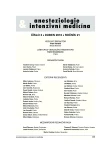Acute kidney injury in critically ill patients – update 2009
Authors:
Chvojka Jiří; Raděj Jaroslav; Kroužecký Aleš; Karvunidis Thomas; Novák Ivan; Matějovič Martin
Authors‘ workplace:
I. interní klinika, JIP, Lékařská fakulta v Plzni, Univerzita Karlova v Praze a Fakultní nemocnice Plzeň
Published in:
Anest. intenziv. Med., 21, 2010, č. 3, s. 146-152
Category:
Intensive Care Medicine - Review Article
Overview
Acute kidney injury (AKI) represents a significant problem in the intensive care units and is associated with high short - and long-term morbidity and mortality, thereby requiring awareness and considerable expertise from intensive care physicians. In this article we summarize and discuss the relevant articles published in the realm of AKI in 2009. Astonishingly, more than 1180 references were published on this issue in the PubMed database during 11 months of the last year. We focused on selected issues whose analysis might contribute to improving the management of critically ill patients with AKI.
Keywords:
acute kidney injury – sepsis – rhabdomyolysis – cardio-renal syndrome – fluid resuscitation
Sources
1. Kumar, A. et al. Duration of hypotension before initiation of effective antimicrobial therapy is the critical determinant of survival in human septic shock. Crit. Care Med., 2006, 34, p. 1589–1596.
2. Bagshaw, S. M. et al. Acute kidney injury in septic shock: clinical outcomes and impact of duration of hypotension prior to initiation of antimicrobial therapy. Intensive Care Med., 2009, 35, p. 871–881.
3. Bagshaw, S. M. et al. Early acute kidney injury and sepsis: a multicentre evaluation. Crit. Care, 2008, 12, p. R47.
4. Hoste, E. A. et al. RIFLE criteria for acute kidney injury are associated with hospital mortality in critically ill patients: a cohort analysis. Crit. Care, 2006, 10, p. R73.
5. Kinsey, G. R. et al. Inflammation in acute kidney injury. Nephron Exp. Nephrol., 2008, 109, p. e102–e107.
6. Dellinger, R. P. et al. Surviving Sepsis Campaign: international guidelines for management of severe sepsis and septic shock: 2008. Intensive Care Med., 2008, 34, p. 17–60.
7. Sakr, Y. et al. High tidal volume and positive fluid balance are associated with worse outcome in acute lung injury. Chest, 2005, 128, p. 3098–3108.
8. Payen, D. et al. A positive fluid balance is associated with a worse outcome in patients with acute renal failure. Crit. Care, 2008, 12, p. R74.
9. Bouchard, J. et al. Fluid accumulation, survival and recovery of kidney function in critically ill patients with acute kidney injury. Kidney Int., 2009, 76, p. 422–427.
10. Mehta, R. L. et al. Spectrum of acute renal failure in the intensive care unit: the PICARD experience. Kidney Int., 2004, 66, p. 1613–1621.
11. Rivers, E. et al. Early goal-directed therapy in the treatment of severe sepsis and septic shock. N. Engl. J. Med., 2001, 345, p. 1368–1377.
12. Lin, S. M. et al. A modified goal-directed protocol improves clinical outcomes in intensive care unit patients with septic shock: a randomized controlled trial. Shock, 2006, 26, p. 551–557.
13. Wheeler, A. P. et al. Pulmonary-artery versus central venous catheter to guide treatment of acute lung injury. N. Engl. J. Med., 2006, 354, p. 2213–2224.
14. Triverio, P. A. et al. Long-term prognosis after acute kidney injury requiring renal replacement therapy. Nephrol. Dial. Transplant., 2009, 24, p. 2186–2189.
15. Saudan, P. et al. Adding a dialysis dose to continuous hemofiltration increases survival in patients with acute renal failure. Kidney Int., 2006, 70, p. 1312–1317.
16. Hsu, C. Y. Linking the population epidemiology of acute renal failure, chronic kidney disease and end-stage renal disease. Curr. Opin. Nephrol. Hypertens., 2007, 16, p. 221–226.
17. Macedo, E. et al. Renal recovery following acute kidney injury. Curr. Opin. Crit Care, 2008, 14, p. 660–665.
18. Basile, D. P. Challenges of targeting vascular stability in acute kidney injury. Kidney Int., 2008, 74, p. 257–258.
19. Schmitt, R. et al. Recovery of kidney function after acute kidney injury in the elderly: a systematic review and meta-analysis. Am. J. Kidney Dis., 2008, 52, p. 262–271.
20. Krouzecky, A. et al. Rhabdomyolysis –development, causes, sequelae and therapy. Vnitr. Lek., 2003, 49, p. 668–672.
21. Bosch, X. et al. Rhabdomyolysis and acute kidney injury. N. Engl. J. Med., 2009, 361, p. 62–72.
22. Matejovic, M. et al. Acute kidney injury in sepsis: is renal blood flow more than just an innocent bystander? Intensive Care Med., 2007, 33, p. 1498–1500.
23. Lappalainen, H. et al. Elimination kinetics of myoglobin and creatine kinase in rhabdomyolysis: implications for follow-up. Crit Care Med., 2002, 30, p. 2212–2215.
24. Forman, D. E. et al. Incidence, predictors at admission, and impact of worsening renal function among patients hospitalized with heart failure. J. Am. Coll. Cardiol., 2004, 43, p. 61–67.
25. Mullens, W. et al. Importance of venous congestion for worsening of renal function in advanced decompensated heart failure. J. Am. Coll. Cardiol., 2009, 53, p. 589–596.
26. Damman, K. et al. Increased central venous pressure is associated with impaired renal function and mortality in a broad spectrum of patients with cardiovascular disease. J. Am. Coll. Cardiol., 2009, 53, p. 582–588.
27. Chvojka, J. et al. Renal haemodynamic, microcirculatory, metabolic and histopathological responses to peritonitis-induced septic shock in pigs. Crit Care, 2008, 12, p. R164.
28. Costanzo, M. R. et al. Ultrafiltration versus intravenous diuretics for patients hospitalized for acute decompensated heart failure. J. Am. Coll. Cardiol., 2007, 49, p. 675–683.
Labels
Anaesthesiology, Resuscitation and Inten Intensive Care MedicineArticle was published in
Anaesthesiology and Intensive Care Medicine

2010 Issue 3
Most read in this issue
- Multiple organ dysfunction syndrome (MODS) – from molecules to the bedside
- Xenon inhalational anaesthesia in volunteers
- Sugammadex (Bridion®) – our first experience with the reversal of moderate rocuronium-induced neuromuscular block
- N-terminal pro-Brain natriuretic peptide (NT-proBNP) in acute brain disease: Elevated serum levels without sodium imbalance
